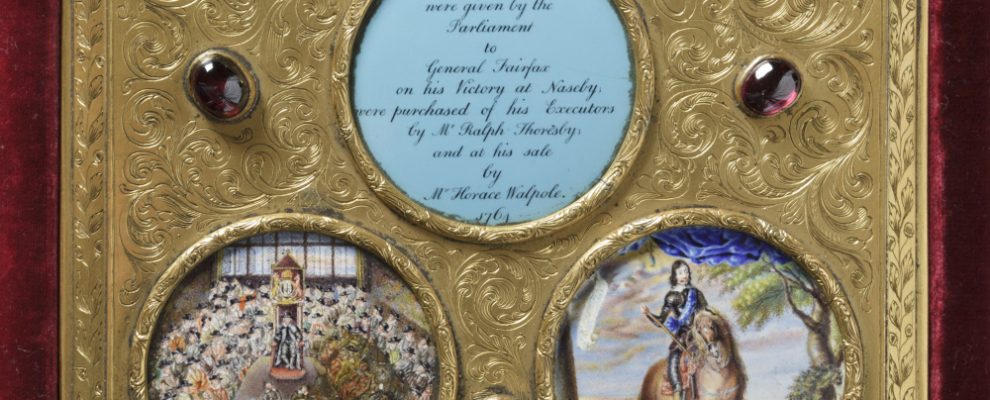The Fairfax Jewel is the name given to a series of three mid-seventeenth-century enamel roundels presented by Parliament to Sir Thomas Fairfax, known as ‘Black Tom’, 3rd Baron Fairfax (1612-1671). They celebrate his victory against Royalist forces during the Civil War at the Battle of Naseby on 14 June 1645. The enamels were originally set in a gold locket in the form of a watch-case with a diamond border, suspended from a blue ribbon worn around the neck. Early in the nineteenth century the enamels were recast in their current decorative gilt metal plaque with three red cabochons, and the blue enamel with commemorative text was added.
The enamels were painted by Pierre Bordier, a notable seventeenth-century Huguenot miniaturist, and depict scenes relating to the Battle of Naseby and Sir Thomas’s subsequent success. The first, on the left-hand side, shows the House of Commons in session with the Speaker in the Chair in the centre, to acknowledge Fairfax’s Parliamentarian allegiance.
The second enamel is double-sided. The convex recto, visible in the plaque, shows an image of Fairfax on his charger Chessnut, with the battle raging in the background. He holds a banner inscribed ‘Sic radiant fideles’ (‘So the faithful shine’). Ironically, this portrait is modelled on Van Dyck’s equestrian portraits of Charles I, showing that the powerful iconography of the mounted military leader crossed the political divide between Parliamentarians and Royalists. The concave verso shows Royalist forces being routed at Naseby under a banner inscribed ‘Non nobis’ – the first words of Pslam 115: ‘Not onto us, O lord, not onto us, but unto thy name give glory’.
Sir Thomas, whose nickname ‘Black Tom’ is said to have derived from his dark hair and swarthy complexion, was a Fairfax of the Denton branch of the family, and arguably his military role in the English Civil War has made him the most famous of all the Fairfaxes. He had strong connections with York: when the city fell to the Parliamentarians after the Siege of York in 1644, Sir Thomas acted to ensure that the stained glass and fabric of the Minster and other churches were not damaged.
While the word jewel often evokes connotations of precious stones and elaborate ornament, the Fairfax Jewel embodies the commemorative and representative aspects of jewellery. Although it has not hung in its diamond bordered locket for 300 years, its value still stands as a commemoration of a great Fairfax achievement. Its uniqueness as a military decoration is commented upon in the letter that accompanies it.
The Jewel’s passage of ownership is reflective of the eighteenth-century collecting tradition and of the recognition of its historical value, acknowledged beyond the Fairfax family. Following Sir Thomas’s death, the Jewel was owned by the antiquary Ralph Thoresby, then by Horace Walpole who kept it as part of his collection of antiquities at Strawberry Hill, and then by the Astley family, for whom historical interest prevailed over Royalist family allegiance. In 2009, the Jewel was purchased for Seaton Delaval Hall with grants from the Art Fund and Sir Siegmund Warburg’s Voluntary Settlement.

Source: Crowning Glory (Fairfax House, 2013)
